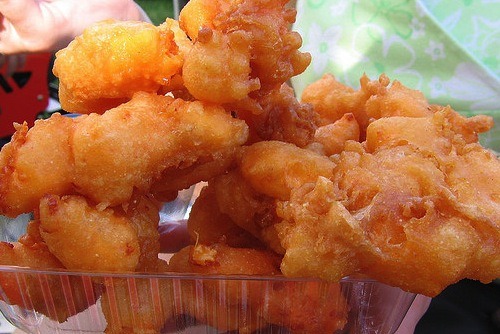It was from Wisconsin. Although the cheese selection from Minnesota wasn’t wholly disappointing, it was certainly underwhelming. Most of the cheeses were from Wisconsin dairy, as explained in my post entitled “Not for all the cheese in Minnesota”. Notably there were some interesting cheeses from Australia that I had never seen before, but otherwise there was a larger Wisconsin cheese selection.
White cheddar cheese curds
I was told, on good authority that cheese curds were something to check out. So, I went out and got some when I had a break in my schedule.
Now there were also yellow cheddar curds. What’s the difference between white and yellow cheddar cheese? This is a pretty good question, and without getting completely side tracked, the answer is rather simple: Not a whole lot. Typically cheddar ranges from white to light yellow after it is produced, depending on various conditions—e.g. the quality/source of the milk, etc. The only real difference is that during the cheese making process an additive called annatto is introduced which gives yellow cheddar it’s deep golden color. Getting even more off track, sharp mild and what have you is determined based on the amount of time the cheddar has been aged—typically getting sharper with age.
Getting back to business
So, how did I choose white cheddar? I don't know. Don't ask me hard questions. I just extended my arm, picked it up off the shelf and put it into my shopping basket. They both taste the same, so it doesn’t matter either way.

What are cheese curds?
Remember Little Miss Muffet, how she ate her curds and whey? Well, during the cheese making process, milk is soured, and from that milk separates curds (the milk protein) and whey (water). So, all cheese is curds, but they are usually pressed into wheels, for thousands of reasons—one of which, longer shelf life. So, as mentioned, cheese curds refers to the actual milk protein of soured milk, as well as, this specific type of cheese.
What is squeaky cheese?
Squeaky cheese refers to cheese curds, in that, it is said that truly fresh cheese curds should make a squeaky noise; this is because of the stiffness of the young proteins. This noise is characteristic of only the freshest cheese curds, maxing out at one day. After a day or so, the cheese’s protein structure starts to breakdown and loses its timbre.
How do people eat cheese curds?
You can eat cheese curds in a variety of ways. I ate them fresh. Typically you can eat them as a snack. Many people will assemble skewered appetizers with meats. Often times, cheese curds are available in a variety of flavors with seasonings that range from garlic and herb to jalapeño. When I was reading the list, it reminded me of all of the different varieties of chèvre.
Popular in the midwest, deep fried cheese curds are common fare at carnivals and county fairs. A veritable funnel cake of the cheese world, fried cheese curds, lovingly referred to as cheese balls, are battered and deep fried.

Less obvious, is poutine. What is poutine? This is a Canadian snack that is french fries topped with cheese curds and brown gravy. It was created in Quebec and there are many different varieties.
Wrapping up
I like the idea of cheese curds—they’re bite-sized pieces of cheese. “Cheddar cereal,” if you will. However, as an individual on a business trip, it’s not very economical for me to eat just a handful of cheese curds and then throw the bag out. It’s not like you can save them over night, for the next day. The taste was good, and I would get them again, but next time hopefully be able to share them in a group.
I did eat some more cheese in Minnesota, which will be coming up, so stay tuned.